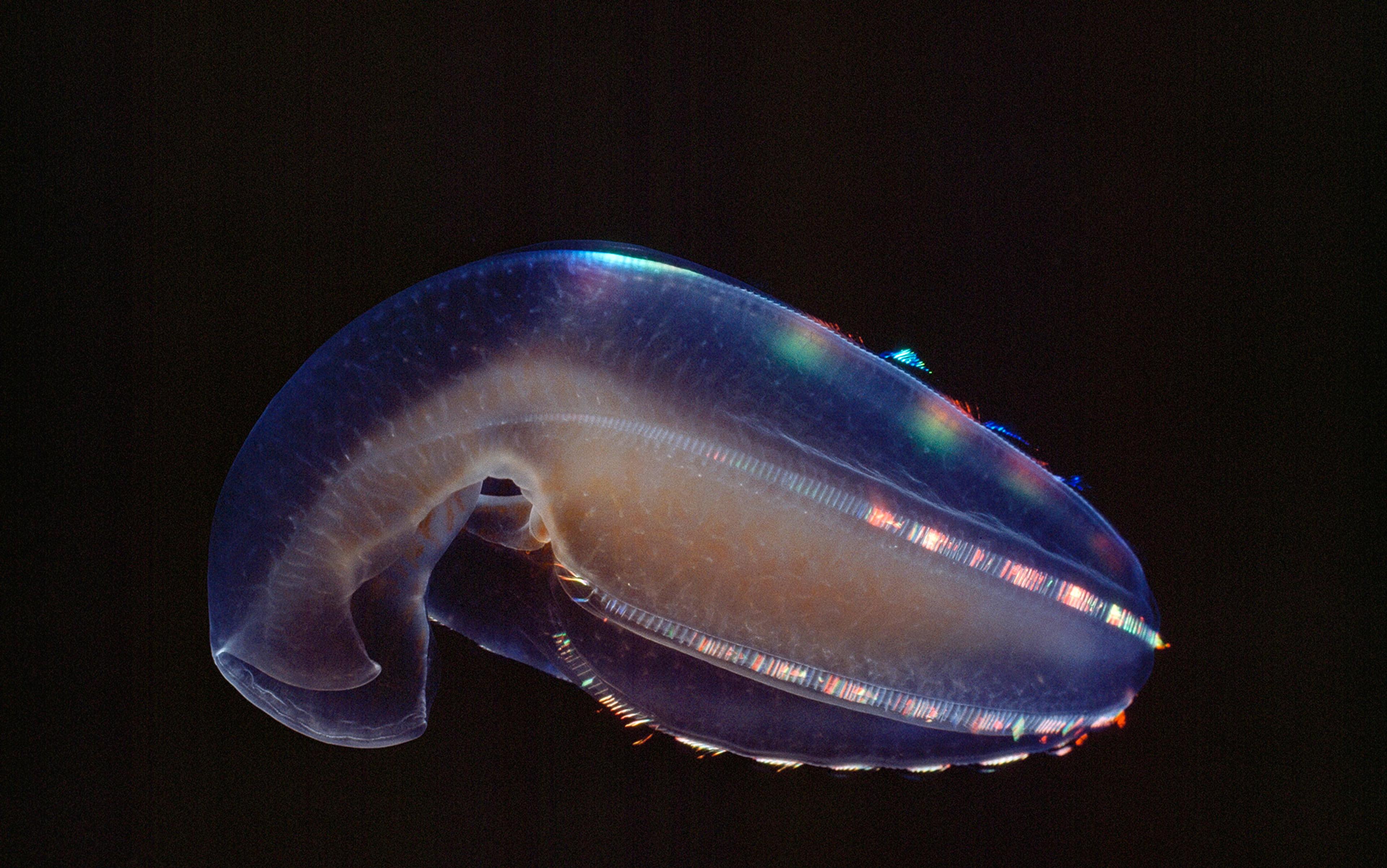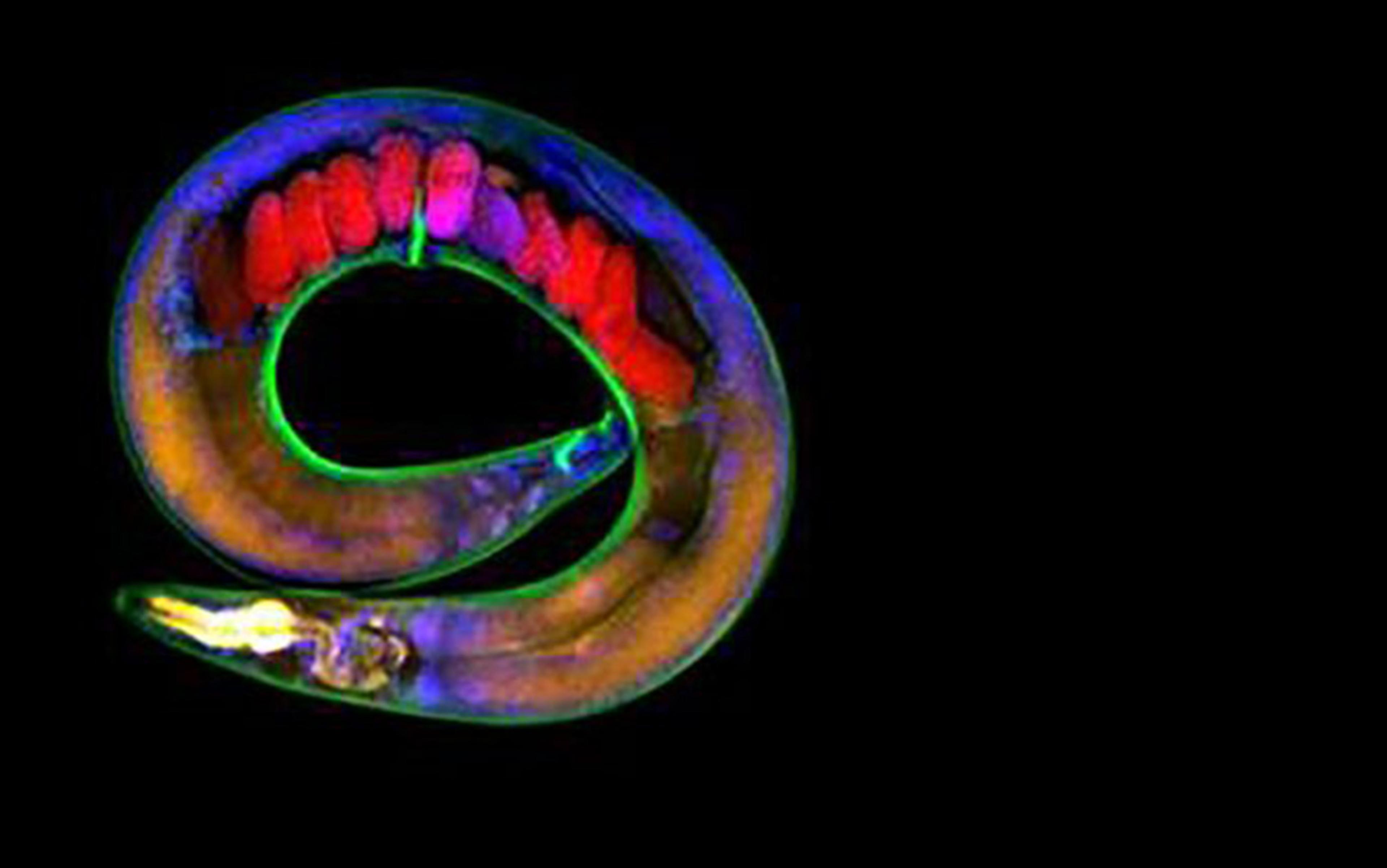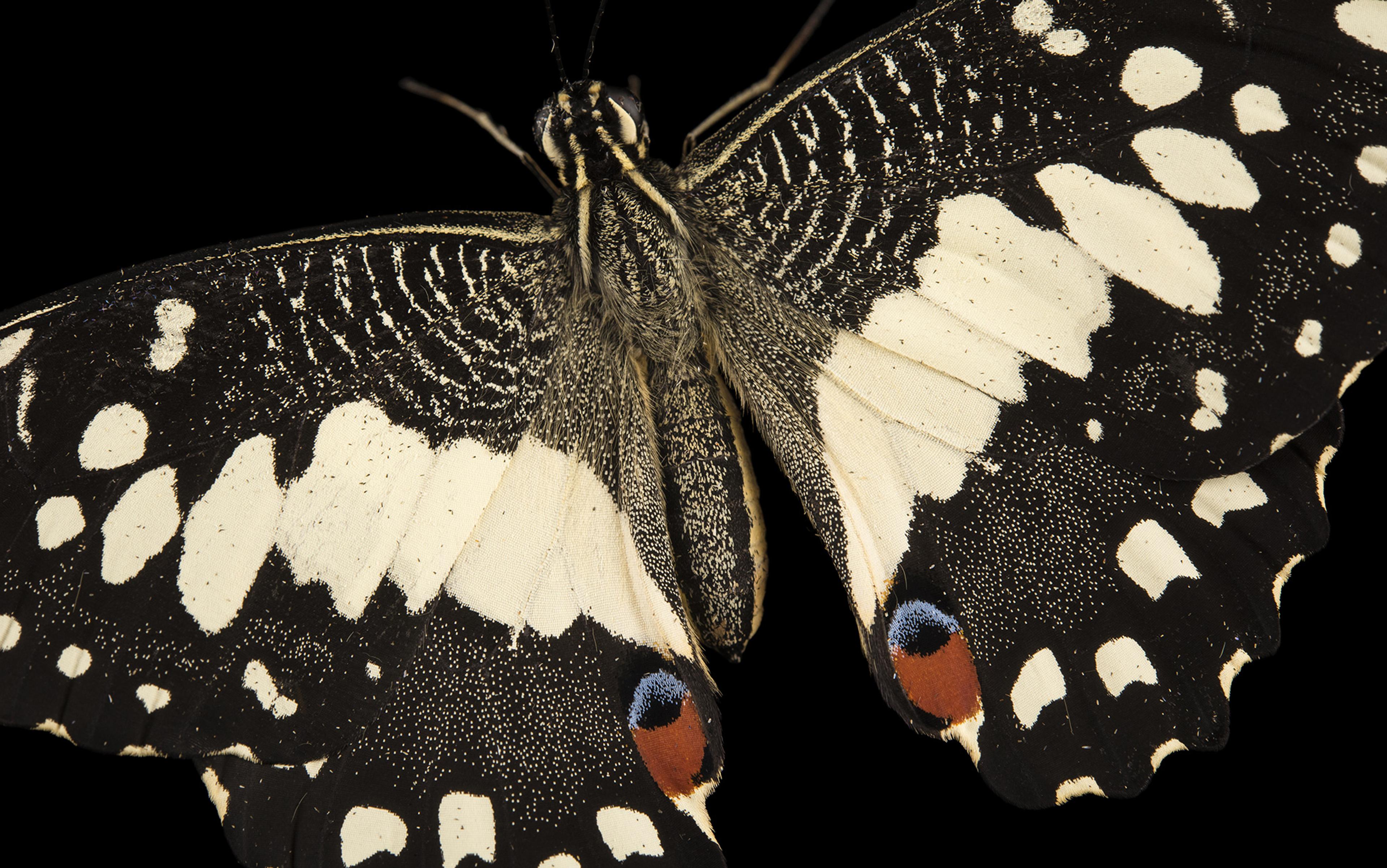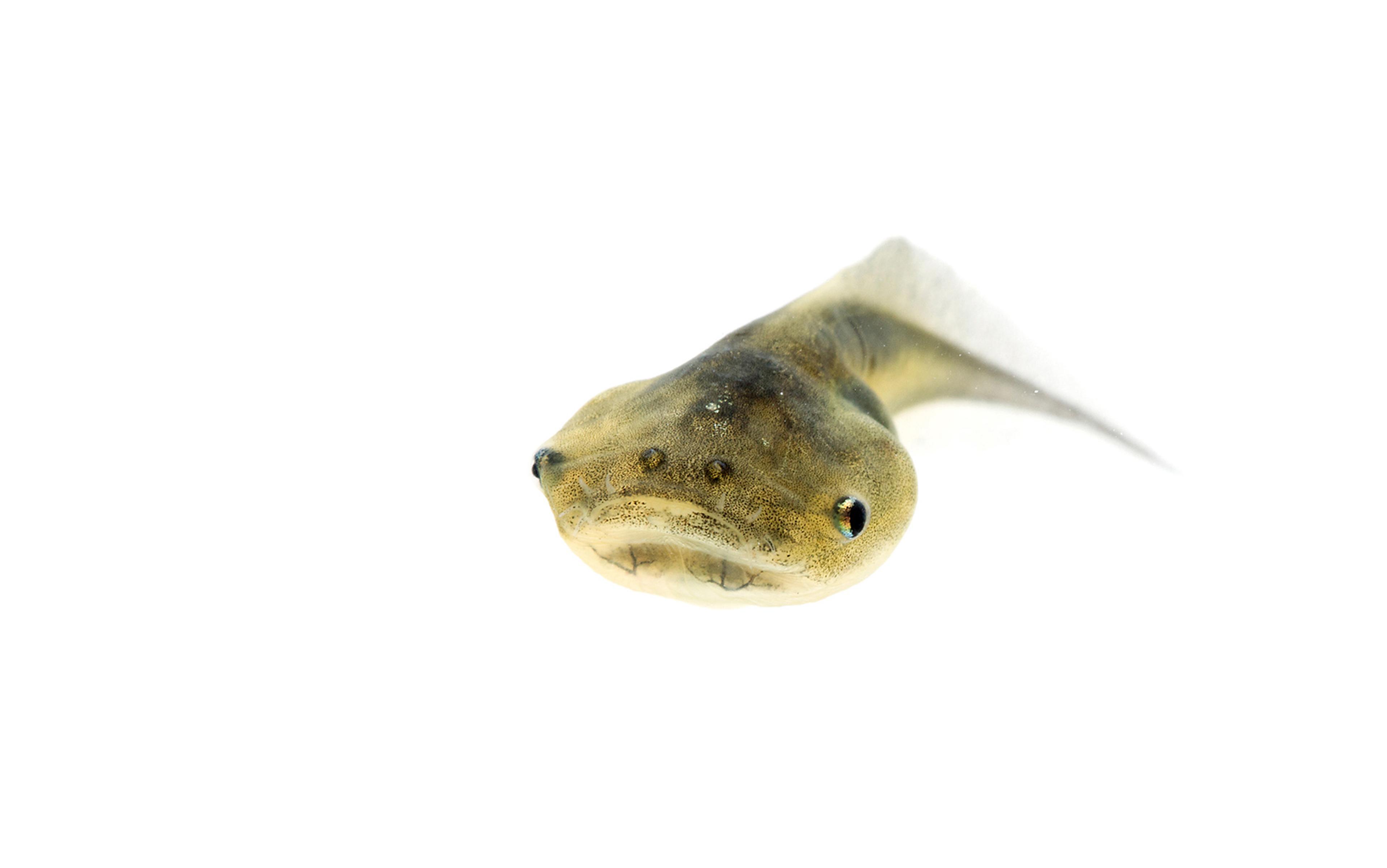Leonid Moroz has spent two decades trying to wrap his head around a mind-boggling idea: even as scientists start to look for alien life in other planets, there might already be aliens, with surprisingly different biology and brains, right here on Earth. Those aliens have hidden in plain sight for millennia. They have plenty to teach us about the nature of evolution, and what to expect when we finally discover life on other worlds.
Moroz, a neuroscientist, saw the first hint of his discovery back in the summer of 1995, not long after arriving in the United States from his native Russia. He spent that summer at the Friday Harbor marine laboratory in Washington. The lab sat amid an archipelago of forested islands in Puget Sound – a crossroads of opposing tides and currents that carried hundreds of animal species past the rocky shore: swarms of jellyfish, amphipod crustaceans, undulating sea lilies, nudibranch slugs, flatworms, and the larvae of fish, sea stars and countless other animals. These creatures represented not just the far reaches of Puget Sound, but also the farthest branches of the animal tree of life. Moroz spent hours out on the pier behind the lab, collecting animals so he could study their nerves. He had devoted years to studying nervous systems across the animal kingdom, in hopes of understanding the evolutionary origin of brains and intelligence. But he came to Friday Harbor to find one animal in particular.
He trained his eyes to recognise its bulbous, transparent body in the sunlit water: an iridescent glint and fleeting shards of rainbow light, scattered by the rhythmic beating of thousands of hair-like cilia, propelling it through the water. This type of animal, called a ctenophore (pronounced ‘ten-o-for’ or ‘teen-o-for’), was long considered just another kind of jellyfish. But that summer at Friday Harbor, Moroz made a startling discovery: beneath this animal’s humdrum exterior was a monumental case of mistaken identity. From his very first experiments, he could see that these animals were unrelated to jellyfish. In fact, they were profoundly different from any other animal on Earth.
Moroz reached this conclusion by testing the nerve cells of ctenophores for the neurotransmitters serotonin, dopamine and nitric oxide, chemical messengers considered the universal neural language of all animals. But try as he might, he could not find these molecules. The implications were profound.
The ctenophore was already known for having a relatively advanced nervous system; but these first experiments by Moroz showed that its nerves were constructed from a different set of molecular building blocks – different from any other animal – using ‘a different chemical language’, says Moroz: these animals are ‘aliens of the sea’.
If Moroz is right, then the ctenophore represents an evolutionary experiment of stunning proportions, one that has been running for more than half a billion years. This separate pathway of evolution – a sort of Evolution 2.0 – has invented neurons, muscles and other specialised tissues, independently from the rest of the animal kingdom, using different starting materials.
This animal, the ctenophore, provides clues to how evolution might have gone if not for the advent of vertebrates, mammals and humans, who came to dominate the ecosystems of Earth. It sheds light on a profound debate that has raged for decades: when it comes to the present-day face of life on Earth, how much of it happened by pure accident, and how much was inevitable from the start?
If evolution were re-run here on Earth, would intelligence arise a second time? And if it did, might it just as easily turn up in some other, far-flung branch of the animal tree? The ctenophore offers some tantalising hints by showing just how different from one another brains can be. Brains are the crowning case of convergent evolution – the process by which unrelated species evolve similar traits to navigate the same kind of world. Humans might have evolved an unprecedented intellect, but the ctenophore suggests that we might not be alone. The tendency of complex nervous systems to evolve is probably universal – not just on Earth, but also in other worlds.
As major animal groups go, the ctenophore is poorly understood. Its body superficially resembles that of a jellyfish – gelatinous, oblong or spherical, with a circular mouth at one end. Ctenophores are abundant in the oceans, but long-neglected by scientists. Well into the 20th century, drawings in textbooks often showed the animal upside down, its mouth hanging toward the seafloor, in jellyfish fashion, whereas in real life, it drifts with its mouth pointed upward.
Unlike the jellyfish, which uses muscles to flap its body and swim, the ctenophore uses thousands of cilia to swim. And unlike the jellyfish with its stinging tentacles, the ctenophore hunts using two sticky tentacles that secrete glue, an adaptation with no parallel in the rest of the animal kingdom. The ctenophore is a voracious predator, known for its ambush tactics. It hunts by spreading its branched, sticky tentacles to form something like a spiderweb, and catches its prey meticulously, one by one.
When scientists began examining the ctenophore nervous system in the late 1800s, what they saw through their microscopes seemed ordinary. A thick tangle of neurons sat near the animal’s south pole, a diffuse network of nerves spread throughout its body, and a handful of thick nerve bundles extended to each tentacle and to each of its eight bands of cilia. Electron microscope studies in the 1960s showed what seemed to be synapses between these neurons, with bubble-like compartments poised to release neurotransmitters that would stimulate the neighbouring cell.
Scientists injected the neurons of living ctenophores with calcium – causing them to fire electric pulses, just as happens in the nerves of rats, worms, flies, snails and every other animal. By stimulating the right nerves, researchers could even prompt its cilia to rotate in different patterns – causing it to swim forward or back.
In short, the ctenophore’s nerves seemed to look and act just like those of any other animal. So biologists assumed that they were the same. This view of ctenophores played into a larger narrative on the evolution of all animals – one that would also turn out to be wrong.
The story of the sponge supported the convenient view that the nervous system had evolved gradually, toward greater complexity
By the 1990s, scientists had placed ctenophores low on the animal tree of life, on a branch next to cnidarians, the group that includes jellyfish, sea anemones and coral. Jellyfish and ctenophores both have muscles, and both have diffuse nervous systems that haven’t fully condensed into a brain. And, of course, both have bodies that are famously soft, jiggly and often transparent.
Below ctenophores and jellyfish on the evolutionary tree sat two other branches of animals that were clearly more primitive: placozoans and sea sponges, which both lacked nerve cells of any kind. The sponge in particular had seemed just barely on the cusp of animalhood: not until 1866 did the English biologist Henry James Clark demonstrate that the sponge was, indeed, an animal.
This helped to enshrine the sponge as our closest living link to an ancient, pre-animal world of single-celled protists, akin to modern-day amoeba and paramecium. Researchers reasoned that sponges had evolved when ancient protists gathered into high-rise colonies, with each cell using its flagella – threadlike structures akin to cilia – for feeding instead of swimming.
This narrative supported the convenient view that the nervous system had evolved gradually, toward greater complexity with each successive branch of the animal tree. All animals were sons and daughters of a single moment of evolutionary creation: the birth of the nerve cell. And only once, in subsequent evolution, had those neurons crossed a second momentous threshold – aggregating into a centralised brain. This view was bolstered by another line of evidence: striking similarities in the way that individual nerve cells were arranged in insects and humans, into neural circuits underlying episodic memory, spatial navigation and overall behaviour. In fact, scientists held, the first brain must have appeared quite early, before the ancestors of insects and vertebrates parted evolutionary ways. If this was true, then the 550 to 650 million years elapsing since that event would represent a single storyline, with multiple animal lineages elaborating on the same, basic brain blueprint up and down the chain.
This picture of brain evolution made sense, but observing the scene at Friday Harbor in 1995, Moroz began to suspect that it was profoundly wrong. To demonstrate his hunch, he collected several species of ctenophores. He sliced their neural tissue into thin slivers and treated them with chemical stains indicating the presence of dopamine, serotonin or nitric oxide – three neurotransmitters that were widespread across the animal kingdom. Again and again, he looked into the microscope and saw no trace of the yellow, red or green stains.
Once you repeat the experiments, says Moroz: ‘You start to realise it’s a really different animal.’ He surmised that the ctenophore was not just different from its supposed sister group, the jellyfish. It was also vastly different from any other nervous system on Earth.
The ctenophore seemed to follow an entirely different evolutionary pathway, but Moroz couldn’t be sure. And if he published his results now, after looking at just a few important molecules, people would utterly dismiss them. ‘Extraordinary claims require extraordinary evidence,’ says Moroz. And so he embarked on a long, slow road, one even longer than even he suspected at the time.
He applied for funding to study ctenophores using other techniques – for example, looking at their genes – but gave up after being turned down multiple times. He was still young at that point, had left the Soviet Union only a few years before, and had only just started publishing his work in English-language journals where it would generate broader interest. So Moroz put ctenophores on a back burner and returned to his primary work, studying neural signalling in snails, clams, octopuses and other molluscs. It was only by chance, 12 years later, that he returned to his passion project.
In 2007, he briefly visited Friday Harbor for a scientific conference. One evening, he strolled out onto the same docks where he had spent so much time in 1995. There, by chance, he glimpsed the iridescent sparkles of ctenophores drifting under the light of a lantern. Scientific tools had advanced by then, making it possible to sequence an entire genome in days rather than years. And Moroz was now established, with his own lab at the University of Florida. He could finally afford to dabble in curiosities.
So he fetched a net and fished a dozen or so ctenophores, a species called Pleurobrachia bachei, from the water. He froze them and shipped them to his lab in Florida. Within three weeks, he had a partial ‘transcriptome’ of the ctenophore – some 5,000 or 6,000 gene sequences that were actively turned on in the animal’s nerve cells. The results were startling.
First, they showed that Pleurobrachia lacked the genes and enzymes required to manufacture a long list of neurotransmitters widely seen in other animals. These missing neurotransmitters included not just the ones that Moroz had noted back in 1995 – serotonin, dopamine and nitric oxide – but also acetylcholine, octopamine, noradrenaline and others. The ctenophore also lacked genes for the receptors that allow a neuron to capture these neurotransmitters and respond to them.
This confirmed what Moroz had waited years to find out: that when he failed to find common neurotransmitters in ctenophore nerves back in 1995, it wasn’t simply that his tests weren’t working; rather, it was because the animal wasn’t using them in any way. This, says Moroz, was ‘a big surprise’.
‘We all use neurotransmitters,’ he says. ‘From jellyfish to worms, to molluscs, to humans, to sea urchins, you will see a very consistent set of signalling molecules.’ But, somehow, the ctenophore had evolved a nervous system in which these roles were filled by a different, as-yet unknown set of molecules.
The ctenophore had evolved from the ground up, using a different set of molecules and genes than any other animal known on Earth
Moroz’s transcriptome and genomic DNA sequences showed that the ctenophore also lacked many other genes, known from the rest of the animal kingdom, that are crucial for building and operating nervous systems. Pleurobrachia was missing many common proteins called ion channels that generate electric signals that travel rapidly down a nerve. It was missing genes that guide embryonic cells through the complex transformation into mature nerve cells. And it was missing well-known genes that orchestrate the stepwise connection of those neurons into mature, functioning circuits. ‘It was much more than just the presence or absence of just a few genes,’ he says. ‘It was really a grand design.’
It meant that the nervous system of the ctenophore had evolved from the ground up, using a different set of molecules and genes than any other animal known on Earth. It was a classic case of convergence: the lineage of ctenophores had evolved a nervous system using whatever genetic starting materials were available. In a sense, it was an alien nervous system – evolved separately from the rest of the animal kingdom.
But the surprises didn’t stop there. The ctenophore was turning out to be unique from other animals in far more than just its nervous system. The genes involved in development and function of its muscles were also entirely different. And the ctenophore lacked several classes of general body-patterning genes that were thought to be universal to all animals. These included so-called micro-RNA genes, which help to form specialised cell types in organs, and HOX genes, which divide bodies into separate parts, be it the segmented body of a worm or lobster, or the segmented spine and finger bones of a human. These gene classes were present in simpleton sponges and placozoa – yet absent in ctenophores.
All of this pointed to a stunning conclusion: despite being more complex than sponges and placozoans – which lacked nerve cells and muscles and virtually every other specialised cell type – ctenophores were actually the earliest, oldest branch on the animal tree of life. Somehow over the subsequent 550 to 750 million years, the ctenophore had managed to evolve a nervous system and muscles similar in complexity to those of jellyfish, anemones, sea stars and many types of worms and shellfish, cobbled together from an alternative set of genes.
Moroz tried to publish his results in 2009. The paper was rejected. And so he continued doing more experiments.
Even as Moroz firmed up his results through the late 2000s, other research teams were beginning to piece together bits of what he already knew – raising the worrying prospect that, after so many years, someone else might arrive at his conclusions before he had a chance to publish them himself.
First, a study in Nature in 2008 called into question the basic structure of the animal tree of life, undermining the long-held assumption that sponges were the first, most primitive branch. That study compared the DNA sequences of 150 genes in order to reconstruct the evolutionary relationships of 77 different animal species – including two species of ctenophores. For the first time ever, this paper publicly suggested that intricate ctenophores – and not simple sponges – might actually be the earliest branch. The mere suggestion of this created ‘a firestorm’ in the scientific community, says Steven Haddock, a biologist with the Monterey Bay Aquarium Research Institute who co-authored that study.
In December 2013, another team published the first-ever genome of a ctenophore – a species called Mnemiopsis leidyi, separate from the one that Moroz has studied the most. That paper, published in Science, also concluded that ctenophores, not sponges, were the evolutionary branch closest to the origin of all animals.
Despite being more complex than sponges, ctenophores seemed to be closest to the origin of all animals
Over the next few months, the deeply rooted narrative that sponges were the earliest animals continued to fall apart in other ways. In January 2014, Sally Leys, one of the world’s leading sponge biologists, based at the University of Alberta in Edmonton, called into question the 150-year-old narrative that sponges were more or less just a colonial version of single-celled organisms thought to be ancestors of all animals. Detailed studies showed that the sponge and the cells of a protist called a choanoflagellate used a different set of genes and proteins to build similar-looking structures. Therefore, sponges could not have evolved from anything resembling a choanoflagellate. Their similarity under a microscope was yet another deceptive example of convergent evolution: two unrelated organisms evolving similar structures to perform similar functions – but using different genes as starting materials.
These studies blew apart the circumstantial evidence that sponges were the earliest branch of the animal tree of life. What had seemed like a strong argument was simply a case of mistaken identity. Despite being far more complex than sponges, with nervous systems, muscles and other organs, ctenophores now seemed to be the earliest branch, closest to the origin of all animals.
But none of those studies had looked at nerve cells in any detail. So the broader world still didn’t know the core of Moroz’s discovery: the separately invented nervous system.
Moroz spent the intervening years filling the gaps in his evidence. His team slowly sequenced the last several percent of his own Pleurobrachia ctenophore genome, slogging through difficult stretches of DNA that gummed up even modern technologies. Moroz hired three dozen students to do detailed studies of what genes were expressed in the individual nerve cells of the ctenophores, and how these cells wired themselves into circuits as the animal developed from an embryo.
Moroz finally published his genome of the ctenophore Pleurobrachia in Nature, in June 2014. His work, seven years in the making, firmly established that the ctenophore’s nerve cells and nervous system had evolved separately from those of all other animals. To him, the ctenophore represented the closest thing to an alien brain, or mind, on Earth.
Ctenophores provide an extreme, striking example of what is probably a general pattern: just as eyes, wings and fins evolved many times over the course of animal evolution, so too have nerve cells. Moroz now counts nine to 12 independent evolutionary origins of the nervous system – including at least one in cnidaria (the group that includes jellyfish and anemones), three in echinoderms (the group that includes sea stars, sea lilies, urchins and sand dollars), one in arthropods (the group that includes insects, spiders and crustaceans), one in molluscs (the group that includes clams, snails, squid and octopuses), one in vertebrates – and now, at least one in ctenophores.
‘There is more than one way to make a neuron, more than one way to make a brain,’ says Moroz. In each of these evolutionary branches, a different subset of genes, proteins and molecules was blindly chosen, through random gene duplication and mutation, to take part in building a nervous system.
What’s fascinating is how these different pathways of evolution arrived at nervous systems that look so similar across the animal tree of life. Take for example the work of Nicholas Strausfeld, a neuro-anatomist at the University of Arizona in Tucson. He and others have found that the neural circuits underlying smell, episodic memory, spatial navigation, behaviour choice and vision in insects are nearly identical to those performing the same functions in mammals – despite the fact that different, though overlapping, sets of genes were harnessed to build each one.
These similarities reflect two key principles of evolution, factors that are probably important on any world where life has emerged. The first is convergence: these far-flung branches of the evolutionary tree arrived at common designs for a nervous system because they each had to solve the same fundamental problems. The second is shared history: the idea that all of these differently built nervous systems shared at least some element of common origin. On our world, they each evolved from molecular building blocks that were forged in the physical and chemical environments of early Earth.
In fact, much of the basic signalling machinery of all nervous systems might have evolved from a life-or-death adaptation that arose in the first cells on Earth, four billion years ago. Early cells probably inhabited aquatic environments, such as hot springs or brine pools, that contained a mixture of dissolved minerals including some, like calcium, that threatened life. (Important biological molecules such as DNA, RNA and ATP are known to coalesce into refractory goo when exposed to calcium – similar to the scum that forms in bathtubs.) So biologists surmise that early life must have evolved ways to keep all but the lowest levels of calcium outside its cells. This protective machinery might include proteins that pump calcium atoms out of a cell, and an alarm system that goes off when calcium levels rise. Evolution later harnessed this exquisite responsiveness to calcium to signal within and between cells – to control the beating of cilia and flagella that microbes use to move, or to control the contraction of muscle cells or trigger the electric firing of neurons in organisms such as ours. By the time nervous systems began to emerge, roughly half a billion years ago, many of the critical building blocks were already set.
If the history of Earth was rewound, evolution might not arrive at 2017 with the same animal groups we see today
These principles have huge implications for understanding evolution, and understanding the forms that life might take on Earth or in other worlds. They shed light on the relative importance of accident and destiny in shaping the trajectory of evolution over billions of years.
The late Harvard palaeontologist Stephen Jay Gould argued in his book Wonderful Life (1989) that accidents matter: that the evolutionary history of animals has been shaped by decimation as much as by innovation. He pointed out that the Cambrian world 570 million years ago contained more groups of animals, called phyla, than exist today. Those diverse branches in the early animal tree were steadily pruned by mass extinctions. Those extinctions fuelled evolution by opening ecological niches that surviving animal groups could diversify into – providing opportunity for innovation.
At the same time, Simon Conway Morris, a palaeontologist at the University of Cambridge, has stressed the importance of evolutionary convergence: that evolution tends to arrive at the same solutions over and over again, even in distant branches of the animal tree, and even when the proteins or genes used to build a similar structure are not themselves related.
Take these two ideas to their logical ends, and one arrives at a startling conclusion. If the history of Earth was rewound and played back, evolution might not arrive at this present year with the same assortment of animal groups that we see today. Mammals or birds, perhaps even all vertebrates, might be absent. But evolution might still arrive at most, or even all, of the same innovations that permitted the emergence of sophisticated brains: those innovations might simply emerge on other branches of the animal tree.
As scientists speculate what kind of life might exist on other worlds, a provocative idea is taking hold: that alien life, unlike anything we know, might already exist here on Earth. The idea is that life might have arisen two or more times on our planet – not just once, as long assumed. Our form of life came to dominate, while other forms receded into the corners. This ‘shadow biosphere’ would be difficult to detect, since it might not contain DNA, proteins or the other molecules that we rely on to detect life.
The phylum of ctenophores isn’t quite that exotic. It is based on the same basic chemistry that we share, but it still represents a shadow biology for animals. Ctenophores are a long-lost cousin that we didn’t even know we had.
Because the ctenophore invented brains and muscles using a set of proteins and genes so different from any other animal that has ever been studied, it provides a unique opportunity to explore some enormous questions: how divergent can nervous systems be? Do we truly understand how life senses its surroundings and behaves?
The ctenophore could even provide useful insights for predicting how nervous systems might evolve in other worlds, in more exotic life forms not based on DNA or proteins. Evolutionary biologists believe that even life based on exotic biochemistry will still tend to be built along similar lines of organisation. Nick Lane, a biochemist at University College London, has written that extraterrestrial life probably compartmentalises itself within some sort of cell membrane, and powers itself using electrochemical differences in the pH or ion concentrations from one side of the membrane to the other, just like cells on Earth. Chemicals extracted from ancient meteorites can readily form membranes – even if those membranes aren’t composed of the exact same molecules. And once cell membranes become fixed in the biology of another world, the process of evolving a nervous system will likely unfold in a manner similar to that seen on Earth.
Moroz is still trying to learn what he can from the ctenophores. These animals were neglected for so long by scientists, in part, because they were so fragile and difficult to keep alive in the lab. Moroz is circumventing this by outfitting a ship with modern research equipment for sequencing genomes, growing embryos, and stimulating neurons in living animals on site. He hopes that by teasing apart the neural circuits of the ctenophore, he can learn more about the design principles of brains in general – and test whether those principles really are universal, or not.
Just getting to this point has been a long process. In order to realise that ctenophores really were so alien, Moroz first had to reject much of what he had learned from researchers who came before. Because his ‘initial hypothesis was exactly what was in the textbooks’, he explains, moving to a new way of thinking took him 20 years.






